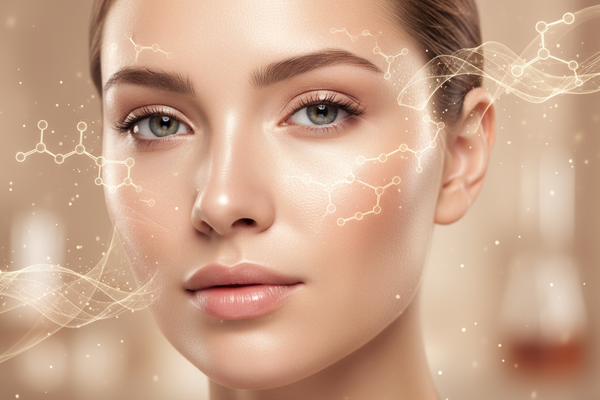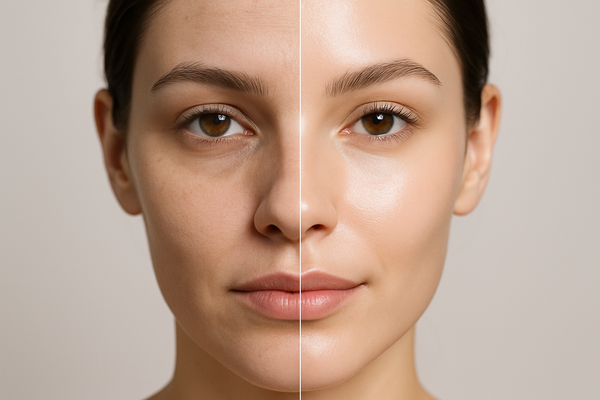Stress & Hormones: Why Your Skin Reacts—and How to Heal It

We talk about “stressed skin” all the time, but what does that really mean? Under the surface, your skin listens to your nervous system, hormones, and immune system every second of the day. When life gets intense, that mind–skin conversation shifts—and your glow, pores, breakouts, and spots show it.
This guide explains exactly what’s happening (in simple language), why skin looks dull or reactive during stress, how hormones drive acne and sensitivity, why pores seem larger, and what you can do—inside and out—to bring your skin back to balance.
The Mind–Skin Connection in 60 Seconds
When you feel stressed, your brain flips on the HPA axis (hypothalamus–pituitary–adrenal). That signal:
-
Releases cortisol (main stress hormone) and adrenaline.
-
Alters insulin and androgens (oil-stimulating hormones).
-
Disrupts sleep hormones (melatonin, growth hormone).
-
Activates neuropeptides (like Substance P), which talk directly to oil glands and immune cells in your skin.
Your skin isn’t just a passive “cover.” It has receptors for these messengers—so it reacts immediately: more oil, more inflammation, slower repair, weaker barrier, and reduced microcirculation.
What “Dull Skin” Really Is (and why stress causes it)
“Dull” isn’t just a vibe. It’s a combination of measurable shifts:
-
Slower cell turnover → dead cells collect at the surface, scattering light → less radiance.
-
Reduced microcirculation from stress/adrenaline → less oxygen/nutrient delivery → a flat, tired look.
-
Barrier dehydration (higher TEWL—transepidermal water loss) → skin looks deflated instead of bouncy.
-
Oxidative stress (free radicals from cortisol spikes + pollution/UV) → uneven tone and that “greyish” cast.
-
Glycation (sugar + proteins → AGEs) rises with stress eating/spikes in insulin → stiffens collagen → dull, rough texture.
Result: light doesn’t bounce; it gets absorbed or scattered. That’s why even great makeup won’t sit right during high-stress weeks.
Why Pores Look Bigger Under Stress
-
More oil (sebum) from cortisol/androgens stretches pore openings.
-
Loss of collagen support (cortisol ramps up collagen-breaking enzymes, MMPs) lets pores “collapse” into tiny shadows that look larger.
-
Inflammation & swelling around the follicle edge makes pores more visible.
-
Dehydration accentuates texture; dry walls make the opening look wider.
Good news: when you reduce oil + support collagen + rehydrate + calm inflammation, pores look tighter again.
Breakouts, Spots, and “Why Now?”
Stress drives acne through four pathways:
-
Oil surge (cortisol → androgens → sebaceous glands).
-
Sticky dead cells (slowed turnover) trap oil in pores.
-
Microbiome shift (barrier disruption) favors acne-prone conditions.
-
Inflammation (neuropeptides, immune signaling) turns clogged pores into visible blemishes.
Post-blemish spots linger longer because stress slows healing and can over-stimulate melanocytes (pigment cells), especially in medium-to-deeper skin tones.
Environmental Stress: The Outside Layer of the Problem
Daily exposures amplify internal stress:
-
UV: accelerates collagen breakdown, pigmentation, and fine lines.
-
Pollution/ozone/PM2.5: triggers free radicals → inflammation, dullness, clogged look.
-
Blue light (screens): contributes to oxidative stress.
-
Climate extremes: heat/humidity or cold/wind disrupts barrier lipids (ceramides, cholesterol, fatty acids).
Translation: if you’re stressed emotionally and skip protection, you’re doubling the burden on your skin.
The Hormones You Keep Hearing About—Explained Clearly
Cortisol (the stress commander)
-
↑ Oil, ↑ inflammation, ↓ barrier integrity, ↓ collagen, ↓ wound healing → breakouts, sensitivity, lines, enlarged-looking pores, dullness.
Adrenaline & Noradrenaline (fast responders)
-
Short term: flushing; longer term: reduced surface blood flow → pale/tired look, slower nutrient delivery.
Insulin & IGF-1 (blood sugar partners)
-
Stress cravings → spikes → ↑ inflammation and oil → worsened acne, delayed healing; also promotes glycation(dullness, stiffness).
Androgens (DHEA/testosterone)
-
Over-stimulate oil glands—classic jawline/chin congestion in stress cycles.
Estrogen/Progesterone (cyclical balance)
-
Estrogen supports collagen, hydration, and barrier lipids; stress + poor sleep can worsen luteal-phase breakouts when progesterone shifts.
Melatonin & Growth Hormone (beauty sleep team)
-
Poor sleep (common in stress) → less antioxidant defense and tissue repair → dullness, puffiness, slower fade of spots.
How This Feels on Your Face (Symptoms Cheat-Sheet)
-
Looks: dull, uneven, “flat,” larger-looking pores, dark circles, lingering marks.
-
Feels: tight yet oily (paradox!), reactive to products, rougher texture.
-
Behaves: makeup doesn’t sit well, breakouts cluster around chin/jaw/forehead, redness/flare-ups.
Lotta Beauty: Formulated for Stressed Skin
Your line already targets the exact stress patterns above. Here’s how to position each product (and why it works):
-
Grapefruit Gel Cleanser (AM/PM)
-
Why: Lifts excess oil/pollution without stripping barrier lipids, helping normalize pores and calm reactivity.
-
Talking point: “Cleanses deeply, keeps the barrier intact—because stressed skin needs gentle, not harsh.”
-
-
Vitamin C, B, E + Ferulic Acid Serum (AM; PM as spot care for tone)
-
Why: Antioxidants counter cortisol-linked oxidative stress + pollution/UV; Vitamin C brightens dullness and supports collagen; Ferulic stabilizes and boosts efficacy.
-
Talking point: “Your daily antioxidant shield—brightness now, collagen support long-term.”
-
-
Hyaluronic Acid Serum with Peptides (AM/PM)
-
Why: Rehydrates the stratum corneum to reduce TEWL; peptides support repair and bounce, softening texture and the look of pores.
-
Talking point: “Plump, calm, resilient—fast.”
-
-
Silk Dream Glaze Moisturizer (PM or AM/PM if dry)
-
Why: Seals hydration, comforts a compromised barrier, improves light reflection for instant radiance.
-
Talking point: “Locks in calm; brings back that silky, rested glow.”
-
-
Silk Lip Glaze (anytime)
-
Why: Stress dehydrates lips too; this is a micro-ritual of care that keeps the whole face polished.
-
Talking point: “Little luxury, big softness.”
-
If you sell/plan SPF: place it after Vitamin C in the AM. No sunscreen claims here unless your line includes one.
A Simple, Science-Backed Routine (2–4 Weeks to Visible Calm)
Morning (protect + brighten)
-
Grapefruit Gel Cleanser
-
Vitamin C, B, E + Ferulic Acid Serum
-
Hyaluronic Acid + Peptides Serum
-
Silk Dream Glaze (thin layer; or skip if very oily)
-
(SPF if available)
Night (repair + rebuild)
-
Grapefruit Gel Cleanser
-
Hyaluronic Acid + Peptides Serum
-
Vitamin C, B, E + Ferulic (every night if skin tolerates; or alternate nights if sensitive)
-
Silk Dream Glaze (generous seal)
Targeted tips
-
Pores/oil days: double cleanse at night (same cleanser twice) and lighter glaze layer.
-
Dullness: spend 60 seconds massaging serums to boost microcirculation.
-
Sensitivity: mist plain water between layers to buffer and keep hydration high.
Lifestyle Levers That Amplify Your Results
-
Breath work (5–6 breaths/min, 5 minutes): lowers cortisol quickly.
-
Walks/yoga/Pilates: improves circulation → better nutrient delivery to skin.
-
Sleep routine: consistent wake/bedtime; cool, dark room → restore melatonin/growth hormone.
-
Sugar steady: pair carbs with protein/fat to flatten insulin spikes (helps acne + glycation).
-
Screen hygiene: reduce late-night blue light to protect sleep and oxidative balance.
-
“Micro-resets”: 60-second pauses during the day to unclench jaw/shoulders—your skin reads tension.
FAQs (educational sound-bites you can reuse on IG)
Why do I look oily and feel dry?
Stress weakens your barrier (water escapes) while hormones increase oil. Rehydrate + protect the barrier and keep pores clean: HA + Peptides under Silk Dream Glaze, and consistent cleansing.
Can stress cause spots even if I don’t change products?
Yes—hormonal shifts alter oil, inflammation, and healing. Your routine’s job is to stabilize those variables.
Why do post-blemish marks hang around longer when I’m stressed?
Stress slows repair and can heighten pigment response. Keep antioxidants (Vitamin C + Ferulic) daily and be diligent with AM protection.
Do pores actually get bigger?
The opening can stretch with oil and lose support as collagen falls—but the appearance improves when oil is managed, hydration returns, and collagen is supported.
Copy Blocks You Can Use on Site/Product Pages
For Dull/Stress-Tired Skin
“Designed for skin under pressure. Antioxidants, hydration, and barrier care that revive radiance, smooth texture, and bring back your calm glow.”
For Visible Pores
“Balances oil, supports collagen, and rehydrates—so pores look refined, not spotlighted.”
For Stressed Skin
“Gentle, intelligent formulas that help skin bounce back from cortisol spikes, late nights, and city life.”
When to See a Dermatologist
-
Sudden, severe, or painful cystic acne
-
Unexplained rashes, hives, or persistent flare-ups
-
Pigment changes that expand rapidly
-
If you’re pregnant, breastfeeding, or on acne/retinoid/antibiotic treatments—ask about routine adjustments
The Bottom Line
Stress is inevitable. Stressed skin isn’t.
When you understand the hormone pathways (cortisol, adrenaline, insulin/IGF-1, androgens) and how they change oil, barrier strength, inflammation, and collagen—you can intervene with smart skincare and simple daily habits.
Lotta Beauty was built for exactly this moment: real life, real stress, real skin. With daily antioxidants, deep hydration, barrier care, and gentle cleansing, your glow comes back—calmer, clearer, and more resilient.
Your skin is listening to you. Speak kindly. Care consistently. Glow naturally.




